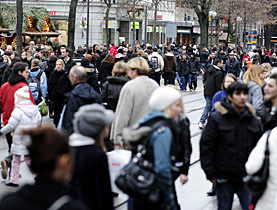Migration drives population increase

Small Switzerland – current population 7.7 million – could see the number of its inhabitants rise to 8.35 million by 2030, according to the latest figures.
The population density will increase, but the country wouldn’t become as crowded as the Netherlands or Britain.
Immigrants will make up the bulk of the population increase, believes the Federal Statistics Office, which released the information. “We expect there to be more arrivals than departures,” the federal office’s Raymond Kohli told swissinfo.
Foreigners, especially Germans encouraged by a healthy economy and a labour accord with the European Union, already helped account for a rise in population to 7.7 million people in 2008, an increase of 1.7 per cent against 2007 and the largest since 1963.
“However, a flux in the other direction cannot be excluded due to the change in the economic situation,” noted the federal office in its recent statistics update.
Births should make up the rest. Last year the birth rate had risen in Switzerland contrary to predictions.
Nevertheless, at 1.48 children per woman, the rate is still insufficient to maintain the population at its current level. For this a rate of 2.1 would be needed.
More older people
By 2050, however, the population will drop again to 8.33 million. Life expectancy is growing and the high numbers of baby boomers – born between 1945-1965 – will be dying out.
“The number of older people is going to rise but the number of younger people is going to stay the same or even get smaller, so that means we’ll have an ageing population with a higher proportion of older people,” Kohli said.
In 2008 there were almost 27 people of retirement age per 100 people of working age. By 2030 this could average at 40 workers per 100 retired people, and by 2050 it could be half and half.
But a larger population won’t make the country too crowded, experts say.
At the moment population density in Switzerland is still far below that of its more crowded European neighbours, the Netherlands and Britain, which have 393 inhabitants per square kilometre and 248 inhabitants per square kilometre respectively, according to United Nations data for 2005.
“In Switzerland it’s currently around 186 people per square kilometre and in 2050 it will be around 201 people per square kilometre, so only 15 people per square kilometre more,” said Kohli.
Populous middle plains
Its mountainous nature means that certain parts of Switzerland are uninhabitable, and that the population is mainly concentrated on the middle plains.
Martin Schuler, professor at the Federal Institute of Technology in Lausanne, told swissinfo that in this part the population density is close to that of the Netherlands. But there are big differences.
“Geneva is a very densely populated agglomeration, Lausanne too, but Zurich is less so and Winterthur not at all, and the acceptance of density is very different,” said Schuler, who also heads Urban Regional Planning Community.
“People in Winterthur are astonished that it is possible to live in Geneva. For people in Geneva it’s no problem, and they even accept moves to intensify this density.”
Migrant urbanites
New migrants are likely to head for the cities. This differs from the past, when Switzerland opened its doors to lower skilled, more rural people from countries like Spain and Bosnia-Herzegovina.
“These new, more highly skilled migrants, people from Germany, the United States or even from Asia, are already urban and used to being in urban contexts,” explained Schuler.
There are no real social problems in Swiss cities, he adds. However, over the past 30 years young Swiss families have been moving out of the towns.
“This means that immigrants in suburban areas are becoming more homogenous, not by origin, but by status, and this is probably part of social injustice,” he said.
Education opportunities and social conditions are not the same, although the labour market still works because of low unemployment.
“This is probably something to take into account in such projects. It is not only a question of how many there are, but how they will live together,” said Schuler.
swissinfo, Isobel Leybold-Johnson
The proportion of young people (less than 20 years old) in the population has dropped from 40.7% in 1900, to 21.5% in 2007.
Numbers of the elderly (more than 64 years old) have increased from 5.8% (1900) to 16.4% (2007).
A marked increase can be seen in the number of people aged 80 and over – 0.5% to 4.7% – in the same period.
Most cantons will see a rise in population by 2030.
Tax paradise Zug should see the largest boom – 19% – by 2030.
Only three cantons – Uri, Glarus and Basel City – should see a fall in population.

In compliance with the JTI standards
More: SWI swissinfo.ch certified by the Journalism Trust Initiative





You can find an overview of ongoing debates with our journalists here. Please join us!
If you want to start a conversation about a topic raised in this article or want to report factual errors, email us at english@swissinfo.ch.